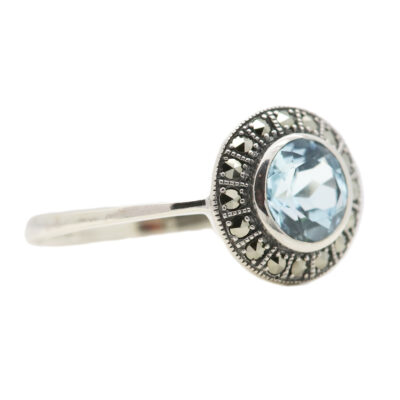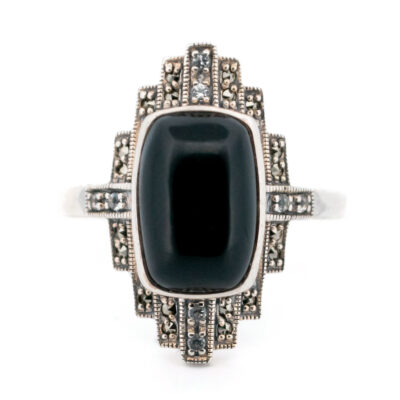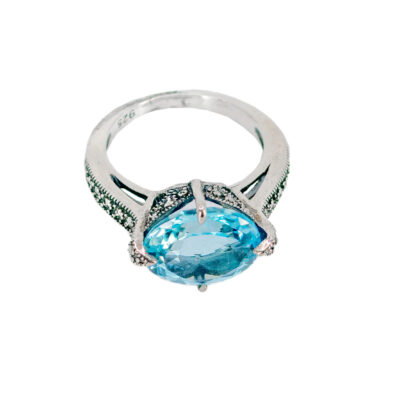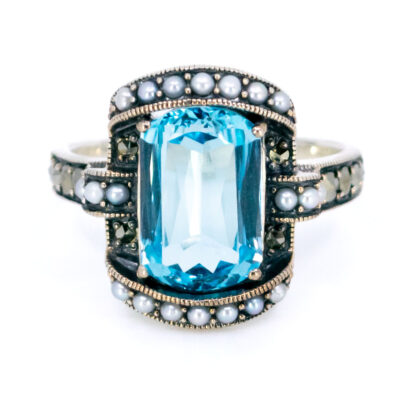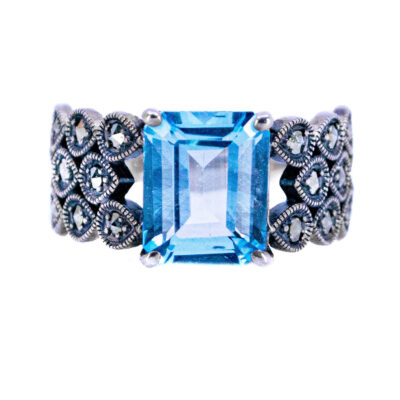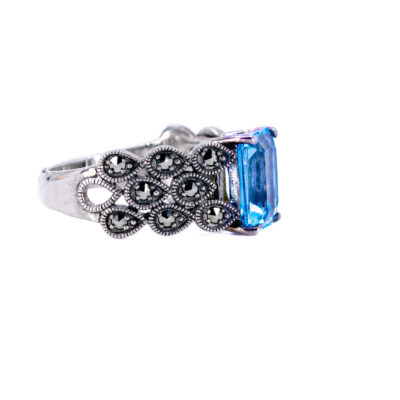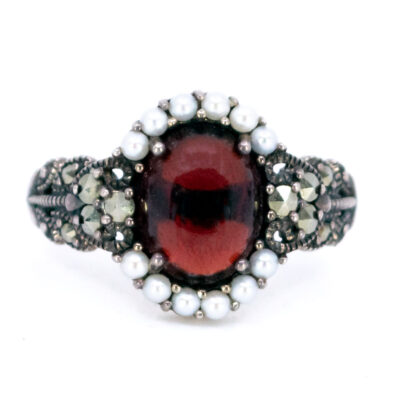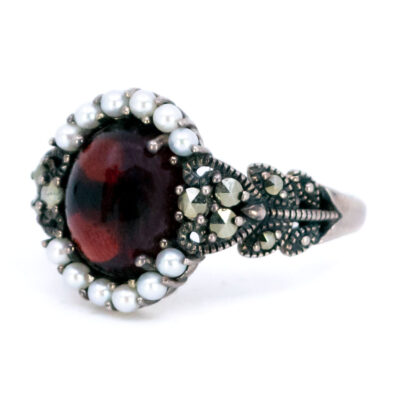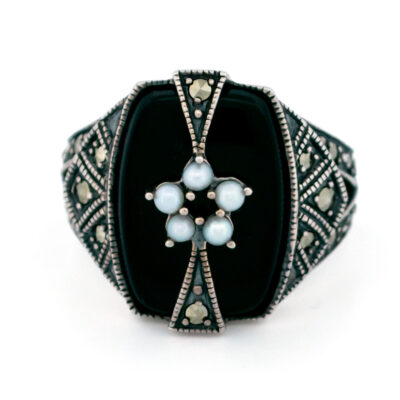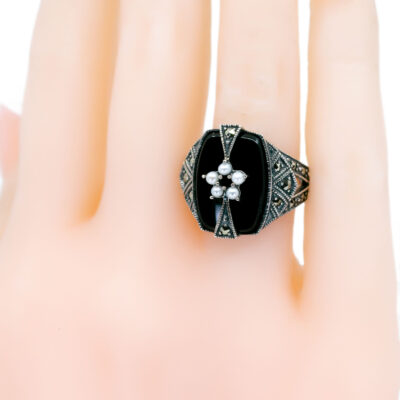This fashionable Art Deco-style ring is made of silver and features topazes as the centerpiece, which are decorated with pearls and marcasites (pyrite). The topazes have an estimated total weight of approximately 2.50 carats. It is a stunning and elegant piece.
Videos
Details: ±2.50ct. Topazes, Pearls, Marcasites (pyrite), Silver Ring.
Design Era: New Art Deco.
Size: 17.53 NL / 55.1 FR / 7¼ US / O UK, sizeable (Within reason. Contact seller for information).
Dimensions: 1.4 x 2 cm .
Weight in grams: 4,8.
Condition: New.
Shipping and Pickup: This stylish piece ships from our store located in the center of Amsterdam, The Netherlands. We offer both registered shipping and local pickup at our store. In the case of local pickup, any applicable shipping costs will be refunded.
About Us: Add some sparkle to your style with Binenbaum.com. We offer a stunning selection of antique and vintage jewelry that you won’t find anywhere else. From timeless rings and dazzling necklaces to unique brooches, we have something for every taste and occasion. Visit our website today and treat yourself to a piece of history.
| Design Era | |
|---|---|
| Design & Historical Context | Art Deco jewelry, also known as Jazz Age jewelry, became popular in the 1920s and remained in style through the 1930s. It was named after the Exposition International des Arts Décoratifs et Industriels Modernes, a exhibition held in Paris in 1925 that was largely dedicated to the jewelry arts. This style was inspired by a variety of cultural and artistic movements, such as Oriental, African, and South American art, as well as Cubism and Fauvism. Art Deco jewelry is known for its sharp, straight lines and emphasis on modernity and the machine age. During the Art Deco era, there were significant improvements in diamond cutting techniques, which made diamonds more radiant and sparkling than ever before. This, along with increased prosperity, allowed more people to afford diamond jewelry and engagement rings. Additionally, new casting techniques made it possible to produce more intricate and detailed settings. Art Deco jewelry was not only fashionable but also reflected the social and cultural changes of the time. The bold, modern design of Art Deco jewelry reflected the liberation and empowerment of women during the 1920s and 1930s. Today, Art Deco jewelry is highly sought after by collectors and is often featured in museum exhibitions and high-end auctions. |
| Key Materials | |
| Materials & Craftsmanship | Topaz: The Gem of Clarity and Strength Topaz, known for its brilliant clarity and wide range of colors, is a gemstone that symbolizes strength, healing, and abundance. While naturally colorless, topaz can be found in a variety of hues including golden yellow, blue, pink, and even rare red, with some colors resulting from natural processes and others enhanced by treatments. Historically, topaz has been associated with powerful metaphysical properties. In ancient Egypt, it was believed to be a gift from the sun god Ra, offering protection and healing. The name topaz is thought to derive from the Sanskrit word tapas, meaning fire, or from the ancient Greek island of Topazios, where the stone was first mined. In modern jewelry, topaz is valued for its brilliance and versatility. With a Mohs hardness of 8, topaz is durable enough for everyday wear, making it a popular choice for rings, pendants, earrings, and bracelets. Blue topaz, in particular, has become a favorite for its cool, calming color, often set in silver or white gold to enhance its sparkling clarity. Topaz is more than just a gemstone; it is a symbol of clarity, resilience, and positive energy. Whether chosen for its vibrant color or its deep symbolic meanings, topaz makes an elegant and meaningful choice for jewelry that is both beautiful and enduring. Pearl: The Gem of Elegance and Purity Pearls, with their natural luster and timeless beauty, are one of the most revered gemstones in the world. Unlike other gems, pearls are organic, formed within the soft tissue of mollusks like oysters and mussels. Their formation process results in a smooth, round gem with a soft, iridescent glow, often referred to as the pearl essence. Historically, pearls have been a symbol of purity, wisdom, and wealth. In ancient Rome, they were considered the ultimate status symbol, while in ancient China, pearls were believed to protect against fire and dragons. During the Renaissance, pearls were so highly valued that they were reserved for royalty and nobility, symbolizing perfection and integrity. In modern jewelry, pearls are cherished for their classic elegance and versatility. They are commonly found in a range of colors, from the traditional white and cream to rare black, pink, and golden hues. Pearls are often strung into necklaces, set into earrings, or used as delicate accents in rings and bracelets. Their softness, with a Mohs hardness of 2.5 to 4.5, requires gentle care, but their beauty and sophistication are unmatched. Pearls are more than just a gem; they are a symbol of grace, purity, and timeless style. Their natural origins and understated elegance make them a beloved choice for jewelry that exudes refinement and sophistication. Marcasite (pyrite): The Gem of Timeless Elegance and Vintage Charm Marcasite, often mistakenly referred to as pyrite, is a gemstone that has captivated jewelry enthusiasts for centuries with its metallic luster and vintage appeal. Although marcasite is technically a form of pyrite, true marcasite jewelry is made from pyrite crystals that are cut and polished to create a shimmering, antique look. Historically, marcasite has been admired for its mysterious, reflective surface, often used in intricate, filigree designs during the Victorian and Art Deco periods. In the 18th and 19th centuries, it became particularly popular in Europe as a more affordable alternative to diamonds, lending an air of elegance and sophistication to brooches, rings, and other accessories. In modern jewelry, marcasite is prized for its ability to add a touch of vintage charm and drama to any piece. Its metallic, gunmetal-gray hue pairs beautifully with silver settings, and its natural sparkle makes it a standout in both understated and ornate designs. Marcasite is commonly seen in rings, earrings, pendants, and brooches, often set in sterling silver to enhance its classic, antique look. Marcasite is more than just a gemstone; it is a symbol of timeless elegance and enduring style. Its historical significance and unique, reflective quality make it a cherished choice for jewelry that exudes both character and sophistication, perfect for those who appreciate the charm of vintage-inspired designs. Silver: The Metal of Elegance and Versatility Silver, known for its bright, reflective luster, is one of the most beloved and widely used precious metals in the world. This versatile metal has been cherished for thousands of years, not only for its beauty but also for its malleability, making it ideal for crafting intricate and delicate jewelry designs. Historically, silver has been associated with the moon and considered a symbol of purity, clarity, and protection. Ancient civilizations, from the Egyptians to the Greeks and Romans, valued silver for its beauty and used it to create coins, jewelry, and religious artifacts. In many cultures, silver is also believed to have healing properties, often used in amulets and talismans to ward off negative energy. In modern jewelry, silver is prized for its affordability, versatility, and timeless appeal. Sterling silver, an alloy of 92.5% pure silver and 7.5% other metals (usually copper), is the standard used in high-quality jewelry. Its durability and bright, reflective surface make it an excellent choice for a wide range of designs, from minimalist pieces to ornate creations. Silver can be polished to a high shine or given a matte, oxidized, or antiqued finish to suit various styles. Silver is more than just a metal; it is a symbol of elegance, flexibility, and understated luxury. Its enduring popularity and wide-ranging applications make it a staple in jewelry that can complement any look, from casual to formal, with timeless grace. |
| Size | |
| Dimensions | 1.4 x 2 cm |
| Gender | |
| Weight (in grams) | 4,8 |
| Condition |
By following these tips, you can enjoy your precious jewelry for many years to come.
Related Products
-
Marcasite (Pyrite) Pearl Topaz 925′ Silver Ring 17649-3117
€ 295,00 VAT incl. (where applicable) -
Marcasite (Pyrite) Topaz Silver Ring 17080-2804
€ 135,00 VAT incl. (where applicable) -
Onyx Marcasite (Pyrite) Topaz Silver Ring 13459-1258
€ 195,00 VAT incl. (where applicable) -
Topaz Marcasite (Pyrite) Silver Solitaire Ring 11870-7244
€ 265,00 VAT incl. (where applicable) -
Topaz Pearl Silver Ring 13063-1123
€ 295,00 VAT incl. (where applicable) -
Marcasite (Pyrite) Topaz Silver Ring 16785-2683
€ 245,00 VAT incl. (where applicable) -
Garnet Marcasite (Pyrite) Pearl Silver Ring 9670-6411
€ 265,00 VAT incl. (where applicable) -
Onyx Pearl Marcasite (Pyrite) Silver Ring 14728-1810
€ 245,00 VAT incl. (where applicable)
- Home
- Collection
- Fine Jewelry
- Silver Jewelry
- Silverware
- Boxes
- Candlesticks
- Salt and pepper shakers
- Miniatures
- Salt cellars
- Spoon Set
- Condiments
- Frames
- Napkin Ring
- Spoon
- Oddities
- Cups
- Vases
- Cutlery
- Serving Spoon And Cake Server
- Candlesticks
- Baskets
- Hanukkiah
- Spice Tower
- Yad
- Tea Set
- Sugar Castor
- Napkin Rings
- Wine Bottle Coaster
- Wine Stopper
- Tea Pot
- Jugs
- Rattles
- Hip Flask
- Miscellaneous
- Rings 💍
- About
- Contact






